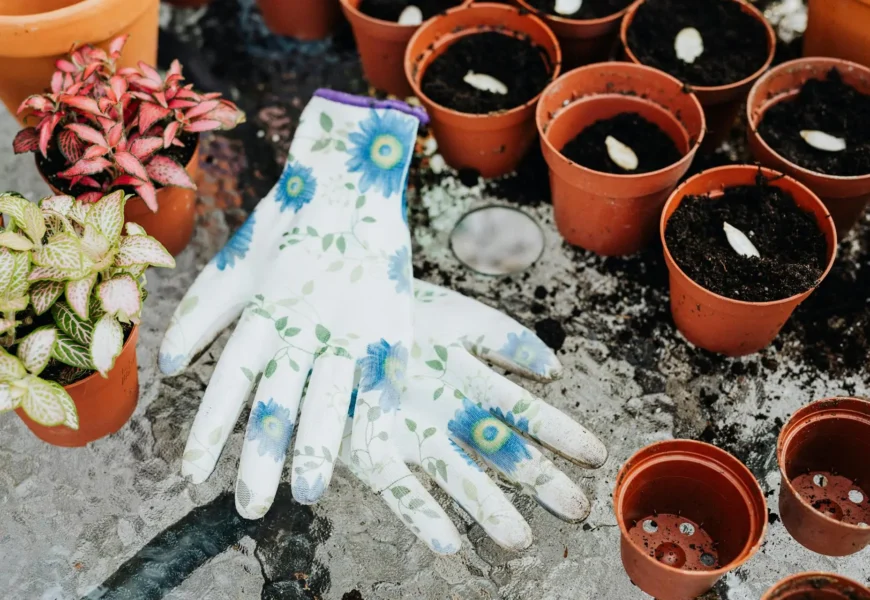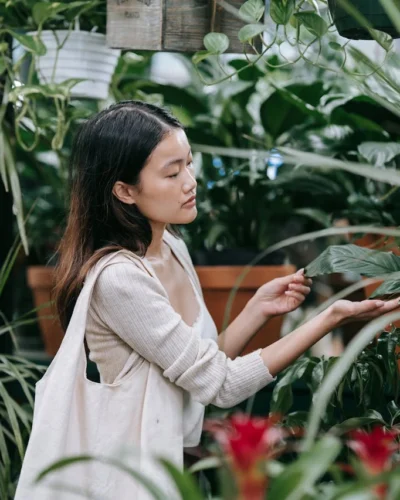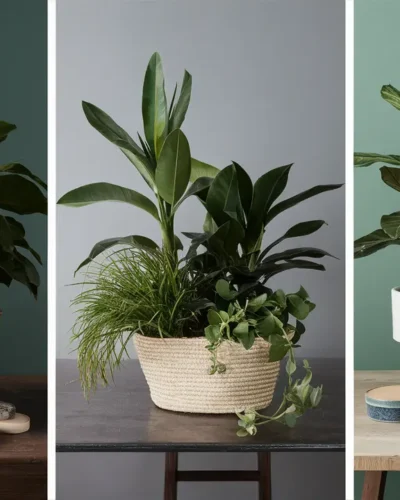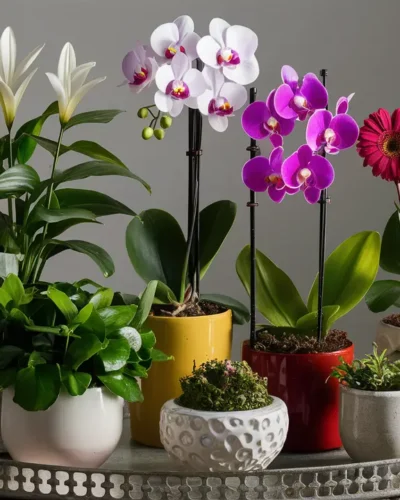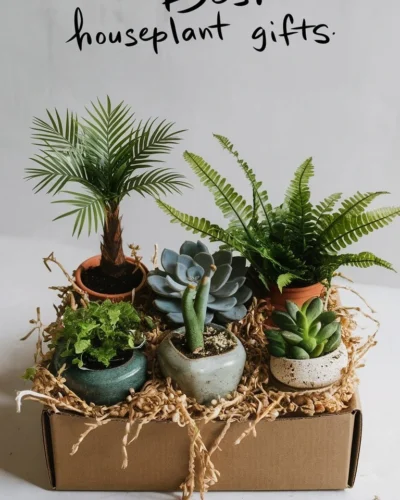Have you ever dreamt of transforming your living space into oasis filled with lush plants? what if we told you that you can grow houseplants from seed and create your dream home with houseplants is not only achievable, but it can also be surprisingly easy and rewarding?
Table of Contents
Introduction
This guide dives into the world of easy-care houseplants grown from seed, offering a solution that’s gentle on your wallet and requires minimal effort.
Before we delve into the practicalities of seed starting, let’s explore the many benefits of incorporating houseplants into your home and the unique advantages of cultivating them from seed.
Easy-Care Houseplants
Easy-care houseplants boast qualities like:
- Drought tolerance: They don’t require frequent watering, making them perfect for forgetful plant owners or those with travel-heavy lifestyles. (Check out our post on ZZ Plants: The Perfect Plants for the Busiest Lifestyles to learn more about a fantastic low-maintenance option!)
- Low light requirements: Many easy-care houseplants can flourish in indirect sunlight, adapting well to apartments or rooms that lack abundant natural light.
- Minimal pest problems: These resilient plants are less susceptible to insect infestations, saving you time and worry.
This doesn’t just mean settling for dull greenery! Easy-care houseplants come in a variety of shapes, sizes, and textures, offering something to complement every style and décor preference.
From the elegant ZZ plant (we can’t recommend it enough – see The Ultimate Guide to Simple ZZ Plant Care for all the details!) to the cascading spider plant, there’s an easy-care houseplant waiting to bring life and personality to your space.
Why Grow Houseplants from Seed?
Houseplants grown from seed offer a unique and rewarding experience that goes beyond simply decorating your home.
It’s about nurturing life from a tiny speck into a thriving plant, witnessing the wonder of nature unfold right before your eyes. But the magic of seeds doesn’t stop there.
1. Key benefits of Growing Houseplants from seed
Let’s explore some of the key benefits of cultivating your houseplant collection from seed:
- Affordability: Seeds are significantly cheaper than purchasing mature houseplants.
- Variety: The selection of seeds available online or at local garden centers is often much broader than what you’ll find in your average nursery.
- Sense of accomplishment: Witnessing a seed sprout and grow into a beautiful houseplant is an incredibly rewarding experience.
- Fresher Plants: Seeds often have higher germination rates than commercially propagated plants, leading to healthier and more vigorous houseplants in the long run.
2. Additional factors
Here are some additional factors to consider when choosing seeds for your houseplant journey:
- Skill Level: If you’re a complete beginner, opt for seeds with high germination rates and minimal care requirements. Some easy seed-starting options include snake plants, ZZ plants (our favorite!), spider plants, and peace lilies.
- Maturity Time: Consider how long you’re willing to wait for your seeds to mature into full-grown plants. Some houseplants, like palms, can take years to reach their full potential, while others, like herbs, can be ready for harvest within a few months.
- Personal Preference: Ultimately, the best seeds are the ones that excite you! Choose varieties that complement your décor style, interest you visually, or offer practical benefits like air purification or edible greens.
When it comes to sourcing high-quality seeds, look for reputable online vendors or garden centers specializing in houseplants. Avoid seeds that are past their expiration date or those from unknown sources, as they may have lower germination rates or harbor diseases.
In the next section, we’ll delve into the practical steps of planting your dream, guiding you through the seed-starting process for your easy-care houseplants!
Step-by-Step To Grow Houseplants from Seed?
Now that you’re brimming with enthusiasm for cultivating your own easy-care houseplants from seed, let’s get our hands dirty and embark on the planting journey! Here’s a step-by-step guide that will walk you through the seed-starting process, ensuring a smooth and successful experience:
1. Gathering Your Supplies:
Before diving in, ensure you have all the necessary materials on hand. Here’s a checklist to get you started:
- Seed Starting Mix: Opt for a sterile, well-draining seed starting mix specifically designed for seedlings. Avoid using garden soil, as it can be too dense and harbor pathogens harmful to delicate seedlings.
- Seedling Pots or Trays: Choose small pots or trays with drainage holes to prevent waterlogging. Recycled containers like yogurt cups or egg cartons can work in a pinch, as long as you poke drainage holes in the bottom.
- Watering Can: A small watering can with a fine nozzle is ideal for gently watering your seeds without disturbing the soil. Alternatively, a spray bottle can be used for a more precise misting.
- Clear Plastic Wrap or Humidity Dome (Optional): Maintaining consistent moisture levels is crucial for seed germination. A clear plastic wrap or a humidity dome placed over your pots can help create a mini greenhouse environment.
- Plant Labels (Optional): Labeling your pots with the plant variety and sow date will help you keep track of your seedlings’ progress.
2. Selecting and Preparing Your Seeds:
- Read the Seed Packet: Each seed variety has specific planting requirements. Carefully read the information on the seed packet regarding planting depth, germination time, and any special pre-treatment needs (such as scarification for some seeds).
- Choose Healthy Seeds: Select plump, firm seeds that are free of blemishes or discoloration. Discard any broken or damaged seeds.
3. Planting Your Seeds:
- Moisten the Seed Starting Mix: Fill your pots or trays with the seed starting mix and moisten it thoroughly until evenly damp. Aim for a consistency similar to a well-wrung sponge.
- Sow Your Seeds: Refer to the seed packet for the recommended planting depth for each variety. For small seeds, gently press them onto the surface of the mix and lightly cover them with a thin layer of moistened mix (around the thickness of a seed). Larger seeds can be planted deeper, following the packet instructions.
- Label Your Pots (Optional): If using labels, write down the plant variety and sow date on each pot for easy tracking.
- Maintain Moisture: Use your watering can or spray bottle to gently water the soil surface, ensuring it’s evenly moist but not soggy.
- Create a Mini Greenhouse (Optional): Cover your pots or trays with clear plastic wrap or a humidity dome to trap moisture and create a warm environment for germination.
4. Providing the Perfect Environment:
- Light: Most seeds require light for germination. Place your seedlings in a bright, indirect light location, such as a south-facing window with filtered sunlight. Avoid direct sunlight, which can scorch delicate seedlings.
- Warmth: Seeds germinate best in warm temperatures, ideally between 70-80°F (21-27°C). If necessary, use a heat mat placed under your pots to maintain optimal soil temperature.
- Ventilation: While maintaining humidity is important, it’s equally crucial to provide some ventilation. If using a humidity dome or plastic wrap, remove it periodically (like for an hour daily) to prevent mold growth.
Next Steps: Patience and Observation
Seed germination can take anywhere from a few days to several weeks, depending on the variety. Be patient and observe your seedlings closely. Once they sprout, gradually reduce humidity by removing the plastic wrap or humidity dome for longer periods.
In the next section, we’ll explore how to nurture your newly emerged seedlings and guide them on their journey to becoming thriving houseplants in your dream home!
Caring for Your Seedlings
The joy of witnessing your seeds sprout into tiny seedlings is truly special. Now comes the exciting yet crucial phase of nurturing them into healthy, thriving houseplants that will transform your dream home. Here’s how to care for your young plants and ensure they flourish:
1. Light and Temperature:
- Adjusting Light: Once your seedlings sprout, gradually increase the amount of light they receive. Aim for 12-16 hours of bright, indirect sunlight daily. Consider supplementing natural light with grow lights, especially during winter months.
- Temperature Consistency: Maintain a consistent temperature range between 65-75°F (18-24°C). Avoid placing your seedlings near drafts or sudden temperature fluctuations.
2. Watering Wisely:
- Watering Frequency: Seedlings have delicate root systems and require consistent moisture, but not soggy soil. Water deeply when the top inch of the soil feels dry to the touch. Avoid overwatering, which can lead to root rot.
- Watering Technique: Water gently at the base of the plant to avoid disturbing the delicate seedlings. Consider using a watering can with a fine nozzle or a bottom-watering technique (placing the pot in a shallow dish filled with water) for even moisture distribution.
3. Thinning Seedlings (Optional):
- Spacing for Growth: Some seeds may germinate too close together, hindering their growth. If necessary, carefully thin out the weaker seedlings to allow proper spacing for the remaining plants.
- Transplanting: Once your seedlings develop their first set of true leaves (those that appear after the initial cotyledons), it might be time to transplant them into individual pots for continued growth. Use a well-draining potting mix suitable for the specific houseplant variety.
4. Fertilizing (Optional):
- Nutrient Boost: Seedlings may not require frequent fertilization in the early stages of growth. However, once they establish a good root system, a diluted solution of a balanced liquid fertilizer can be applied every few weeks during the growing season (usually spring and summer).
5. Addressing Common Issues:
- Leggy Seedlings: This can occur due to insufficient light. Ensure your seedlings receive adequate bright, indirect sunlight.
- Damping-off: Seedlings are susceptible to fungal diseases like damping-off. Ensure proper ventilation, avoid overwatering, and use a sterile seed starting mix.
- Pests: While less common with indoor plants, keep an eye out for pests like aphids or fungus gnats. For organic pest control solutions, you can refer to our blog posts on How to Deter Pets from Chewing on Houseplants and How to Stop Your Dog or Cat From Digging Up Houseplants.
By providing consistent care and monitoring your seedlings’ progress, you’ll be well on your way to raising healthy, vibrant houseplants. In the next section, we’ll delve into incorporating these thriving additions into your dream home and explore the joy of surrounding yourself with a flourishing indoor sanctuary.
Building Your Dream Garden: Showcasing Your Houseplant
Your seedlings have thrived, transforming from tiny sprouts into beautiful young houseplants. Now comes the exciting part: integrating them into your dream home and witnessing the joy and transformation they bring! Here are some tips for showcasing your plant babies and creating a flourishing indoor oasis:
1. Finding the Perfect Placements
- Light Requirements: Consider the specific light needs of each plant variety. Snake plants and ZZ plants (our low-light champions!) can thrive in areas with indirect sunlight, while spider plants and peace lilies appreciate brighter locations. (For a refresher on light requirements for houseplants, check out our guide Sunshine Solutions: Choosing the Best Blinds for Thriving Houseplants !)
- Plant Sizes and Types: Play with heights and textures! Place taller plants on the floor or plant stands to add vertical interest, while trailing varieties like spider plants can be displayed in hanging baskets or on shelves.
- Grouping for Impact: Cluster plants with similar light and watering needs together for a cohesive look and easier care. You can even create a mini indoor jungle by grouping several houseplants on a plant stand or corner shelf. (For inspiration, check out our post Creating a Beautiful Indoor Jungle with Self-Watering Planters )

2. Complementary Décor
- Matching Pots: Stylish pots can elevate the overall look of your houseplants. Choose pots that complement your décor style and the size/color of the plant.
- Creative Containers: Think outside the box! Upcycle vintage teacups, mason jars, or woven baskets for a unique and personalized touch.
- Vertical Gardening (Optional): If space is limited, consider vertical gardening solutions. Wall planters, hanging shelves, or macrame plant hangers can add greenery without sacrificing floor space. (For a deep dive into vertical gardening, check out our post Vertical Gardening: Make the Most of Limited Space)
The Benefits of indoor garden
Surrounding yourself with houseplants not only beautifies your space, but it also offers numerous health and well-being benefits:
- Improved Air Quality: Houseplants act as natural air purifiers, filtering common toxins and pollutants from the indoor environment.
- Stress Reduction: Studies have shown that interacting with plants can lower stress levels and promote feelings of calm and relaxation. (You can learn more about the science behind this in our post How Houseplants Become Your Natural Stress Busters: )
- Enhanced Mood: The vibrant colors and life force of houseplants can uplift your mood and create a more positive atmosphere in your home. (Check out our post Breathe Easy – Beautify Your Living Room: Top Plants for a Healthy, Happy Hom for some mood-boosting plant recommendations!)
By following these tips and incorporating your thriving houseplants into your décor, you’ll be well on your way to transforming your dream home into a flourishing indoor sanctuary.
Conclusion
Congratulations! You’ve embarked on the rewarding journey of cultivating your own easy-care houseplants from seed. From witnessing the magic of seed germination to nurturing your seedlings into thriving greenery, you’ve not only beautified your space but also gained valuable plant parenting skills.
Remember, the key to success lies in choosing easy-care varieties, providing the right growing conditions, and offering consistent care. As your houseplants flourish, so will your dream home, transforming into a tranquil oasis filled with life and natural beauty.
Looking for More?
This guide has hopefully equipped you with the knowledge and confidence to embark on your seed-starting adventure. But the world of houseplants is vast and ever-evolving! Here are some additional resources to fuel your plant passion:
- Boost Your Indoor Garden: The Essential Guide to 10 Growth Factors: Dive deeper into the science of plant growth and discover essential factors to keep your houseplants thriving.
- Fresh Flowers at Home: Easy-Care Guide for Long-Lasting Beauty: Expand your botanical horizons and learn how to bring the joy of fresh flowers into your home with this easy-care guide.
- Explore Our Plant Collection: Browse our extensive collection of blog posts offering tips, tricks, and inspiration for all things houseplants!
Remember, the journey of plant parenthood is a continuous learning process. Don’t be afraid to experiment, embrace challenges as opportunities to learn, and most importantly, enjoy the experience of cultivating your own indoor oasis. Happy planting!
Bonus Section
This section provides an optional deeper dive for readers who want to explore seed starting or specific houseplant care in more detail.
Choosing Unique Seed Varieties:
- Go Beyond the Expected: While popular options like snake plants and spider plants are fantastic, there’s a whole world of unique houseplant seeds waiting to be discovered! Explore online vendors or specialty garden centers to find seeds for uncommon varieties like:
- Air Plants (Tillandsias): These fascinating plants require minimal soil and absorb moisture from the air, making them perfect for terrariums or unique displays.
- Venus Flytrap (Dionaea muscipula): This carnivorous plant adds a conversation starter to any indoor jungle.
- String of Pearls (Senecio Rowleyanus): This unique succulent features cascading pea-like foliage, adding a whimsical touch to your décor.
- Consider Propagation: While seed starting is rewarding, some houseplants can also be propagated through techniques like leaf cuttings or division. This can be a great way to expand your collection without having to start from seed.
Advanced Seed-Starting Techniques
- Seed Scarification: Certain seeds have hard outer shells that benefit from scarification (scratching or nicking) to improve germination rates. Research the specific needs of your chosen seed variety.
- Stratification: Some seeds require a period of cold temperatures to simulate winter conditions before germination. This process, called stratification, can be achieved by placing seeds in a moist, sealed container in the refrigerator for a specific timeframe.
Tips for Specific Houseplants
- ZZ Plant Care: Our ultimate guide provides comprehensive details on caring for your favorite low-maintenance houseplant
- Repotting: Learn how to properly repot your growing houseplants to ensure they have enough space to thrive
- Pet-Friendly Plants: If you share your home with your pets, explore our guide to houseplants that are safe for pets.
Remember, this bonus section is just a starting point! There are endless resources available online and at libraries to delve deeper into the fascinating world of houseplants and seed starting. With a little research and a lot of love, you can cultivate a thriving indoor sanctuary filled with the beauty and joy of plants you nurtured from seed.
FAQ: Growing Your Dream Home with Easy-Care Houseplants from Seed
This FAQ section addresses some common questions you might have after reading the guide:
Is growing houseplants from seed difficult?
No! While there are specific requirements for each variety, many easy-care houseplants thrive when grown from seed. This guide focuses on seed-starting methods suitable for beginners and offers tips for ensuring successful germination and growth.
What are the benefits of growing houseplants from seed?
Growing houseplants from seed offers several advantages:
- Affordability: Seeds are significantly cheaper than purchasing mature houseplants, allowing you to experiment with a wider variety and create a lush indoor jungle on a budget.
- Variety: The selection of seeds available online or at garden centers is often broader than what you’ll find in most nurseries, opening doors to unique and uncommon houseplant varieties.
- Sense of accomplishment: Witnessing a seed sprout and grow into a beautiful houseplant is a rewarding experience, fostering a connection with nature and pride in your plant parenting skills.
- Fresher Plants: Seeds often have higher germination rates than commercially propagated plants, leading to healthier and more vigorous houseplants in the long run.
What are some easy-care houseplants suitable for seed starting?
Many easy-care houseplants can be successfully grown from seed, including:
- Snake plant (ZZ plant)
- Spider plant
- Peace lily
- Air plants (Tillandsias)
- String of pearls (Senecio Rowleyanus)
This is not an exhaustive list, and there are many other options to explore! Consider factors like your skill level, desired maturity time, and personal preferences when choosing seeds.
Where can I find high-quality seeds for my houseplants?
Look for reputable online vendors or garden centers specializing in houseplants. Avoid seeds that are past their expiration date or those from unknown sources, as they may have lower germination rates or harbor diseases.
How much light do I need for seed germination?
Most seeds require light for germination. Place your seedlings in a bright, indirect light location, such as a south-facing window with filtered sunlight. Avoid direct sunlight, which can scorch delicate seedlings.
How often should I water my seedlings?
Seedlings have delicate root systems and require consistent moisture, but not soggy soil. Water deeply when the top inch of the soil feels dry to the touch. Avoid overwatering, which can lead to root rot.
What if my seedlings look leggy?
Leggy seedlings can occur due to insufficient light. Ensure your seedlings receive adequate bright, indirect sunlight.
How do I know when to repot my seedlings?
Once your seedlings develop their first set of true leaves (those that appear after the initial cotyledons), it might be time to transplant them into individual pots for continued growth. Use a well-draining potting mix suitable for the specific houseplant variety.
Do I need to fertilize my seedlings?
Seedlings may not require frequent fertilization in the early stages of growth. However, once they establish a good root system, a diluted solution of a balanced liquid fertilizer can be applied every few weeks during the growing season (usually spring and summer).
I hope this FAQ section has addressed your questions! Remember, the key to success lies in choosing easy-care varieties, providing the right growing conditions, and offering consistent care. With a little patience and love, you can cultivate a thriving indoor sanctuary filled with houseplants you nurtured from seed.

